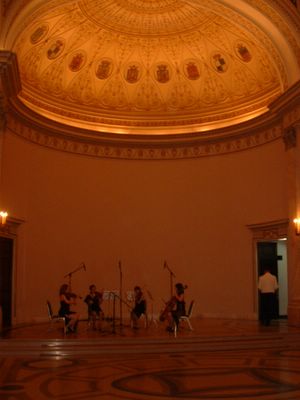AnimalsRomania is home to more large mammals than anywhere else in Europe. Half of Europe’s bears, one third of its wolves, and more than a third of its lynx live in the Carpathian Mountains. The mountains also host stags, wild boars, badgers, deer and foxes. Despite living in the Carpathians I haven’t seen any of the more exotic creatures on that list. I’ve seen a number of deer and foxes, and a couple of weeks ago, driving back from Targu Mures across the Harghita Mountains we had to stop while a badger crossed the road right in front of us (this was the first time I’d ever seen a badger in the wild). A lot of these animals survive partly because the mountains are so wild and uninhabited by humans and partly because they (surprisingly) benefited from Ceausescu’s patronage. Not that he seems to have been some kind of tree-hugging environmentalist hippy, more that he was keen to be the only one allowed to hunt, like some medieval monarch. Hunting by the non-friends of Ceausescu was therefore forbidden for many years, something which benefited the animal population greatly (and really he can’t have had that many friends, when it comes down to it).
When I told my students about the “roast bear” I’d seen in a restaurant in Bucharest, they said that it is still illegal to hunt bears, so they must have been imported. This doesn’t seem likely given the figures mentioned above, so they’re either poached or obtained with some kind of normally impossible to obtain licence. [I finally told my students about the existence of this blog, by the way, and they told me that I’m much more cynical in writing than I am in real life. Bastards. (That’s a joke, Laura)]
Away from the mountains, the Danube Delta is a massive draw for ornithologists, with tons and tons of rare and protected species. I’m very much looking forward to going there sooner or later (tentatively we’re planning a trip this summer). One bird that can be seen here without going to the Delta is the stork. Every village has at least one or two nests on the top of some pole or chimney somewhere. Occasionally you see them flying, these massively wide things swooping down like some kind of stealth bomber.
Oh, and there are mosquitoes too. Bloody loads of them. It is they who are likely to delay my first trip to the Danube Delta as they apparently can be brutal in those parts. And that’s for people who have a normal relationship with mosquitoes. I am apparently one of the most delicious dishes ever placed before the mosquito world, and I’m quite sure they actually travel for miles to eat at me. In fact, I suspect that I’m listed in the mosquito equivalent of the Michelin guide. It’s one of the reasons I keep moving, to try and outfox them before thy can bring out a new edition.
VegetablesThe market has filled up with fruits and vegetables from all over the country as if to prove that summer is really here. It’s quite appealing to be back in a country where the availability of produce is determined by the season, as it means going to the market is a new experience every time. Right now new potatoes have shown up and for the last couple of weeks strawberries have been everywhere. Now they’re starting to be cheap and yesterday I found myself in a queue at the strawberry stall as various people in front of me bought 5, 10, 20 kgs of the things. I was baffled. I mean what are people going to do with that many strawberries? I bought a single kilo and it was still a struggle for us to eat them before they went mouldy. I expressed my surprise to Erika and she looked at me pityingly. “They’re making jam. Making sure they have stuff for the winter.” It’s June! Here in the mountains the winter has only recently finished. For someone for whom advanced planning is wondering at 5pm whether I should get some beers for the evening, this level of forethought is quite incredible.
I imagine in Bucharest you can buy exotic things like pineapples and coconuts and mangoes and tomatoes in January, but here, you just get what comes. Oddly, because the market traders come from all over the country, it’s the one place in town where the salesfolk are (much) more likely to speak Romanian to you than Hungarian.
There’s a big line in picking and consuming wild stuff too – both for herbal remedies and for food. I may have mentioned the amazing mushrooms we had last autumn, and recently I had a plate of nettles (yes, nettles. Picked young and cooked like spinach. They were quite good, though a tad bitter). In other flora related news, my hay fever is brutal this year. I’m typing this through a haze of itching, sneezing, and thick-headedness.
I left England for the first time in 1987 for Valencia. While there I learned a fair amount of Spanish, including the word for carrot,
carlota. Then I moved to Madrid and eventually found myself in a greengrocers asking for a kilo of carlotas. I was greeted with complete incomprehension. It was then that I discovered that the Spanish word for carrots is actually the (much more difficult)
zanahoria. Carlota is the Valenciana word. Why am I telling this story? Well, I fear the same thing may be happening again. I am (painfully slowly) learning Hungarian, and among the words I have learned are those for fruit and veg. The word for carrot is, as far as I knew until a couple of days ago,
murok. But then a couple of days ago, while making something from a Hungarian cook book, I came across a word I had never seen before. I checked with Erika and she told me it was carrot. It was nothing like murok. Again, it is a much more complex word, something like
sargarepa. That apparently is the “real” Hungarian word for it, and the word I know is the Transylvanian Hungarian word, which is derived from the Romanian word
murkov (which in turn must be derived from some Slavic language). I have the feeling that as I learn more I will find out more and more of this stuff. I imagine too that Transylvanian Romanian has some words derived from Hungarian that are not well-known in the rest of the country.
And MineralsWell, I don’t have much to add on the mineral front, not being much of a geologist, but what I can pass on is a quite astounding piece of information I learned last weekend. Now I can’t vouch for this statistic 100%, and I can’t give you some impeccable source for it, but it was told to me by someone who I trust to not merely have made it up. The fact (assuming it is a fact) is this: That there are more mineral water springs in Harghita County (where I live) than in the
rest of Europe combined. That’s right. I really need to find something official to confirm this, as it’s the kind of statistic I want to wield with impunity, dropping it in to my conversation at odd junctures to stun and amaze my listener.







